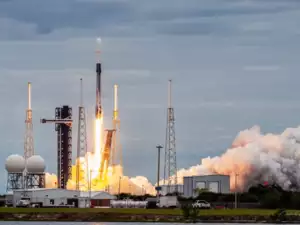New Delhi, 22 Feb: India’s space program is reaching new heights, with a series of ambitious space missions strengthening its position among the world’s leading space powers. The Indian Space Research Organisation (ISRO) has made remarkable progress over the years, paving the way for future missions such as Gaganyaan, Chandrayaan-4, and the Indian Space Station. The latest Space Docking Experiment (SPADEX) further demonstrates India’s technological advancements and commitment to space exploration.
India: A Preferred Satellite Launch Destination
India has emerged as a global leader in satellite launches, gaining international credibility in space technology. The country has successfully launched 433 foreign satellites, with 396 launches in the past decade alone. Between 2014 and 2023, these missions generated a revenue of $157 million.
The historic success of Chandrayaan-3 in 2023, which made India the first country to land near the Moon’s south pole, has positioned ISRO at the forefront of lunar exploration. Even NASA and other global space agencies are now awaiting India’s findings from the Moon’s south pole, reinforcing the country’s dominance in space research.
Indian Space Station: A Major Milestone
One of ISRO’s most ambitious goals is to establish an Indian Space Station by 2035. This project will focus on:
- Scientific experiments in space
- Earth monitoring and deep space research
- Reducing reliance on international partners
Once operational, the station will enable India’s independent presence in space and strengthen its role in international space collaborations.
Chandrayaan Missions: Expanding Lunar Research
India’s lunar exploration journey has seen major breakthroughs:
- Chandrayaan-1 (2008): Discovered water molecules on the Moon’s surface.
- Chandrayaan-2 (2019): Collected crucial scientific data despite a partially failed landing.
- Chandrayaan-3 (2023): First successful soft landing near the Moon’s south pole.
ISRO is now preparing for Chandrayaan-4, which will introduce advanced rovers for detailed lunar surface analysis. The long-term goal is to send Indian astronauts to the Moon and plant the national flag.
Mars Mission: Strengthening India’s Global Standing
The Mars Orbiter Mission (Mangalyaan), launched in 2014, made India the first Asian country to reach Mars’ orbit in its maiden attempt. Following this success, ISRO is developing Mangalyaan-2, aiming to:
- Deploy a lander and rover on Mars.
- Conduct in-depth studies of the planet’s surface, climate, and atmosphere.
- Lay the groundwork for a future human mission to Mars.
Other Ambitious Space Missions
Gaganyaan: India’s First Human Spaceflight
The Gaganyaan mission, set for 2028, will send three Indian astronauts (Vyomnauts) into space, marking a historic milestone for India’s space capabilities.
NISAR: ISRO-NASA Collaboration
The NISAR (NASA-ISRO Synthetic Aperture Radar) mission will monitor climate change, deforestation, and natural disasters, providing crucial environmental insights.
Shukrayaan: India’s First Venus Mission
India’s first Venus exploration mission, Shukrayaan, is planned for 2028. It will study:
- Venus’ atmosphere and geological features
- Surface composition and climatic conditions
- Planetary evolution insights
India’s Space Journey Continues to Impress
With cutting-edge advancements in space technology, ISRO is on track to becoming a global space superpower. Its ambitious projects, including the Indian Space Station, Chandrayaan, Mangalyaan, Gaganyaan, NISAR, and Shukrayaan, are set to further cement India’s role in international space exploration.
These achievements not only enhance India’s scientific and technological expertise but also inspire future generations while strengthening global collaborations.




















